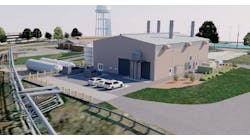When military officials and energy companies gathered last week in Arlington, Virginia to promote microgrids, the fates conspired to make their work very easy.
Just the day before, a power outage knocked out electricity to the White House, the Smithsonian, the Department of Energy, the Justice Department, the University of Maryland, parts of the subway, and other key Washington, D.C. area facilities.
“This was a nice reminder of why we need microgrids and a resilient energy infrastructure,” said Rima Oueid, a DOE senior policy advisor, who spoke at the conference, sponsored by S&C Electric. Oueid said there are no microgrids in the city that she’s aware of.
The outage was disconcerting not only because of where it occurred, but also what caused it.
It was not a cyberattack, a key worry in the *military’s pursuit of microgrids. Nor was it a hurricane, the reason states like Connecticut and New York are installing microgrids.
Instead, it was an everyday sort of accident. A broken wire, which stranded people in elevators, led to building evacuations and left the State Department reliant on a cell phone flashlight for a media briefing.
Think of our electric grid as an elephant that mice can send into a stampede. Never mind the terrorists or the super storms, it is little things that more often overwhelm the grid.
Aging equipment, falling trees, wayward cars and nibbling critters. These mundane events are a large part of why the U.S. suffers more blackouts than any other developed nation, according to Eaton’s Blackout Tracker. In fact, Eaton found that all 50 states experienced power outages last year. And the problem is getting worse; last year the U.S. saw 3,634 outages, up 12 percent, over 2013.
So clearly blackouts can happen anywhere, anytime. Even in North America’s most powerful city.
Which begs the question, why the heck aren’t key buildings in the nation’s capital, of all places, not connected to microgrids?
Microgrids won’t stop grid equipment from failing, but they can keep the lights on for customers while it’s repaired. An advanced microgrid makes the switch so smoothly, customers are unware of any problem.
Hackers Target US Grid
As if commonplace accidents are not enough, military officials at last week’s conference warned of more ominous threats. Hackers are routinely trying to bring down U.S. energy infrastructure. Fortunately, so far, the military’s ‘ethical hackers’ are catching holes in security before the enemy camp succeeds.
“We realize we are not going to be able to thwart every [cyber] attack. That’s where microgrids come in,” said David Curfman, assistant commander and director, public works, Naval Facilities Engineering Command. “Microgrids are considered mission critical. We can’t afford loss of capabilities if the commercial grid fails; we have to be up and running.”
The Department of Defense spends about $2 billion annually on electricity, most of it purchased from the central grid, “which is considered a vulnerability,” said James Galvin, energy and water program manager at the ESTCP, an environmental research arm of the DOD. “So there is a big interest in increasing energy security for electricity. That’s where microgrids play a big role.”
Domino-like Collapse
The power industry speaks often of the spectacular nature of the U.S. electric grid, the world’s largest machine, an interwoven wonder. But what makes the grid impressive, also makes it fragile. Because much of the US grid is interlinked, a malfunction in one place, even a small one, can have a domino effect and cause outages for miles.
For example, the transmission wire break that caused the Washington outage originated in a county about 50 miles from the White House. A 230-kilovolt (kV) transmission line snapped and fell to the ground at an electrical switching station in Charles County, Maryland, according to the Southern Maryland Electric Cooperative. In 2003 the unholy mix of wires and trees in the Midwest left 50 million people without power not only in the Midwest but also in Canada and the Northeast, including New York City.
DC Building Owners Worried
The vulnerability of Washington’s electric grid hasn’t escaped the notice of local building owners. Just a few weeks before the power outage, the DowntownDC Business Improvement District (BID), a private non-profit organization funded by property owners, issued a report bemoaning the city’s lack of advanced electric technology.
The report described the city’s grid as strained and aging, vulnerable to severe weather and reliant on imported power. The organization called for the DC Public Service Commission to pursue the kind of grid modernization underway in New York through its Reforming the Energy Vision, which creates a grid that elevates the use of local energy, including microgrids.
In a prescient statement, the organization warned in the March 24 report that “the lack of work to modernize regulations – to enable and incentivize the deployment of technologies from microgrids to solar – will have an increasingly noticeable impact.”
The report could nudge the city forward with microgrid development. Another source of hope is the merger under review between Exelon and Pepco, the utility that serves D.C. Exelon has agreed to add more distributed energy, including microgrids to nearby Montgomery and Prince George’s counties, should the merger go forward.
Ultimately, the distributed grid is coming to the U.S., pointed out David Chiesa, S&C Electric’s director of microgrid business development. “If you take a look at what Denmark did over the last 20 years, it started off with five large centralized generating stations. Today it has over 100 distributed sources. That’s where we are headed.”
Let’s hope that the nation’s capital will get there before it’s hit with a bigger and more crippling power outage.
What are your thoughts on Washington, D.C. outage? Comment below or on our new LinkedIn Group, Community Microgrids and Local Energy.





